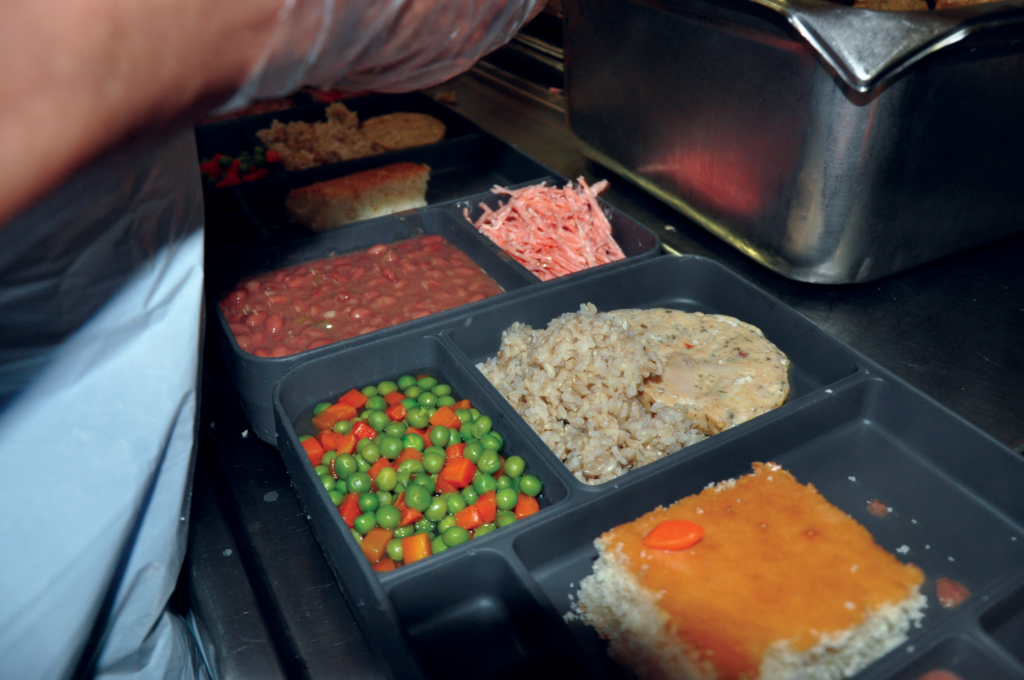Outside organization proposes improvements to food quality and culinary training

The state of California requires two hot meals be served every day to incarcerated persons. But for nearly a week the residents of San Quentin had cold showers and cold food until new boilers were installed. However, numerous residents said they preferred it that way because of the higher quality and quantity of cold food that was served.
Several other residents said the cold meals were plentiful for the first couple of days and then the portions dipped later in the week. Some disliked the frequency of the ham sandwiches while others raved about the turkey pastrami.
“It was tough to shower in cold water at the end of the day, but the opportunity to have good meals was a plus,” resident Adan Arriaga said. “I got tired of the ham sandwiches but the different types of meats were nice.”
Food quality and quantity are complaints often heard from incarcerated persons. Food Service Manager W. Clark said he is open to help change the model for food service in prisons. “Unfortunately, many food service institutions lack the resources and support their need to thrive.”
California’s nutritional guidelines and a budget of $4.30 a day, per inmate, which can make it difficult to prepare quality meals. Another hurdle is the sourcing for the three meals; presently the Prison Industry Authority sets the prices for the goods that the institutions purchase.
Resident kitchen employee Delfino Verdin said the cold sandwiches, fresh fruit, and quality of food were the best San Quentin has provided in years. “The portions were enough to make me full.”
Verdin said it felt good to save a little canteen by going to breakfast, lunch, and dinner. His sentiment was similar to that of several others who expressed the importance of saving some of the money their family and support network provide.
“The fruits and vegetables were refreshing and a change in the flavor of our food felt civilized,” David Torresan said.
Resident Inmate Advisory Council Parliamentarian Kenny Rogers, and head of the food service committee, said the committee did a survey of the population regarding food quality. The IAC Food Survey report stated the biggest complaints were: 70% disliked plant based/no meat meals, 18% said the low quality/flavor and low portions were a concern, and, lastly, poor preparation and variety rounded out the top five.
The report also highlighted the parts of breakfast, lunch, and dinner that residents said get thrown away: 18% beans, 11% carrots, 10% uncooked veggies, and 9% said all of it.
The committee’s survey reported a few of the top five suggestions for improvement: better flavor, better variety, bring back old menus, and more staff training. Rogers said after he read about renowned chef Dan Giusti’s food service program, Brigaid, he immediately believed the program could be implemented in San Quentin to address the concerns of the population.
“Where you buy the food from and the partnerships that can be formed to work with the Chef’s needs to make quality food could solve several issues,” said Rogers.
Brigaid is a for-profit company with a team of 70 chefs working in 35 school districts in California. According to the proposal, since the founding of the program they have serviced public school districts, senior centers, homeless shelters, and correctional facilities in 11 states.
The chefs bring a wealth of experience in professional kitchens and provide operational evaluations to identify needs to improve meal quality and consistency, expand menu options, and develop professionally.
“Getting people in the kitchen that care about food will change the quality,” resident Chris Rigsby said.
Rigsby worked as a chef in food service kitchens prior to coming to prison. “It is about the culture and proper guidance on how to cook broccoli properly, how to flavor beans. If the cooks tasted the food before it is served they could make adjustments.”
Other objectives for the program are to improve resident’s health outcomes, dining experience, and culinary skills. “Everyone who is here can benefit if there is actual training for higher quality food,” Giusti said.
Giusti proposed working with San Quentin kitchen workers to implement an upgraded model for food service in the carceral system and provide marketable trade skills for future work opportunities once workers are released. The curriculum will consist of three modules: food safety and organization, kitchen professionalism, and food quality and presentation.
“I could use culinary skills when I leave here. I believe it could change my quality of life if I had a trade I could go right out and get a career in,” David Torresan said.
Giusti said the trainings would be geared toward improvement of culinary skill, productivity, and worker satisfaction. The partnership will be co-designed by representatives from Brigaid, San Quentin residents, and Food Service Staff. A full-time Brigaid employee will lead an on-the-ground chef for a minimum of two years.
“Why not give someone a credential and training while they are working in prison?” Giusti said. “We want to give people a reason to work in the kitchen. If you want to do it, you can learn a lot and the repetition in prison is a great place to obtain a quantifiable skill.”
“If somebody took the time to come in and teach a workshop on how to cook the food better, I would take advantage,” Verdin said.